Finding new ways to increase efficiency and safety through haul truck customizations.
By Josh Swank
An apple a day keeps the doctor away. This phrase, while overused, offers an interesting point. There is something to be said about a person who looks at their current situation and makes choices that decrease future risk or increase the potential for prospective payoff. Now of course, this article is not about eating enough fruits and vegetables, but the true sentiment of the advice applies to a broad range of topics—including haul road maintenance.
Haul road maintenance can easily be categorized as just an unavoidable expense. While it is a fact that haul roads must be maintained, there are ways to decrease ongoing costs with preventative maintenance and boost efficiency in the process—kind of like a person who eats an apple occasionally or lives a generally healthy lifestyle to lower their medical bills. Through preventative maintenance, operations can address areas that may seem small in the present moment but reduce risk of more significant downtime and headaches in the future. The key is to incorporate equipment that helps operations realize the long-term benefits.
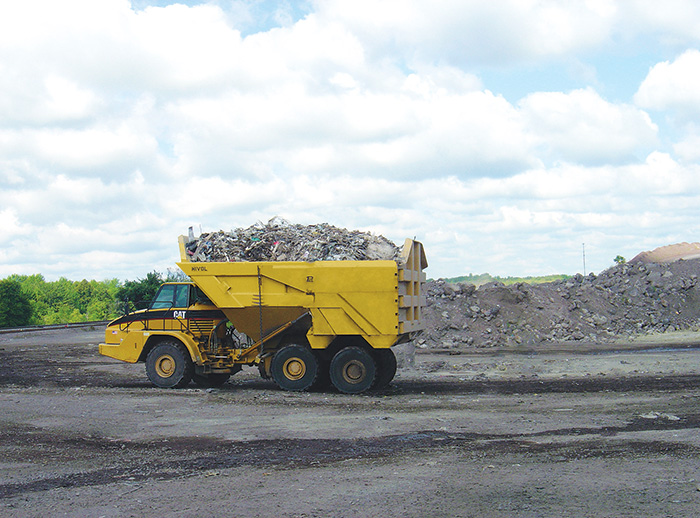
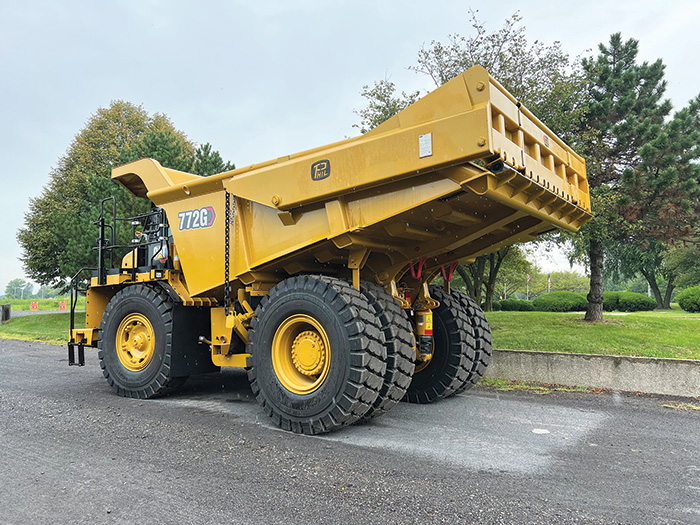
Tread Lightly on Haul Truck Tires
Every minute an operation spends on active haul road maintenance, such as clearing debris or bringing in additional material to repair the effects of wash boarding, it takes a minute away from hauling waste. This inefficiency significantly compounds over time. Also consider the cost of damaged tires, and the financial benefit of proper haul road maintenance quickly adds up.
Waste operations can shell out more than $25,000 to replace just one tire on a haul truck—not a cheap endeavor. Poorly maintained roads are harder on tires, which causes them to wear out faster. Not only does this force more frequent replacement, which subsequently increases costs, but damaged tires also impact operator safety since a haul truck operating on even one problematic tire can easily go out of control without warning.
Adopting preventative haul road maintenance practices that keep roads in good condition significantly reduces these costly risks. Additionally, it offers greater capacity for operations to focus on hauling their required load, rather than diverting resources to repairing roads and replacing tires. Tailgates and custom truck bodies are two custom haul truck solutions that offer a significant benefit to tire life while addressing numerous other avoidable risks.
Do Not Pave the Haul Road with the Haul Load
Good haul road health starts with prevention. Many haul roads in landfills contain an incline, so naturally, gravity pushes the material to the back of the truck beds. When operations use standard off-the-shelf truck bodies, whether driving on the steep part of the haul road or not, material spillage is common because the truck body is not optimized for the material it is hauling and the open back allows gravity and bumps to slide material off the back onto the haul road. Haul truck customizations can address this issue and significantly reduce spillage.
Tailgates added to a standard haul truck allow operations to maximize capacity without risking material spillage. Without a tailgate, operators tend to adjust their loading strategy to decrease the amount of material they place in the truck while also moving the loading target to the front of the body to prevent spillage. Because of this, trucks often carry less than their rated capacity and the additional weight in front leads to faster front tire wear. This is simply not efficient.
While tailgates provide an excellent option to address spillage, waste operations can fully maximize hauling capabilities by replacing the OEM’s standard haul truck body with a custom-engineered body designed to fit the specific needs of the operation. Standard haul trucks are built with the premise of all materials possessing the same material density, resulting in a “one-size-fits-all” approach. Alternatively, custom truck bodies take all aspects of the operation into account, recognizing that properties of refuse differ from those of overburden, coal, or aggregates.
The haul trucks in landfills often only carry one-fourth of the rated capacity of the truck. For example, a common off-highway dump truck in a landfill can usually hold 35 to 40 tons and has a body that can hold roughly 30 cubic yards. But nowhere near 40 tons fits in a standard original equipment manufacturer truck body. Refuse, especially that found in a municipal solid waste landfill, is light and fluffy, weighing an average of 650 pounds per cubic yard. If a 30-cubic-yard body on a 40-ton truck was filled to volumetric capacity with refuse, it only equals 10 tons. Custom truck body manufacturers devised a solution that offers three times the volumetric capacity, 90 to 100 cubic yards, while meeting (not exceeding) the rated capacity of the truck. Custom truck bodies prevent hauling below capacity level simply because space in a standard design is too limited to reach the gross vehicle weight with lightweight material.
Custom truck bodies are also designed to address spillage and ensure that the material stays in the truck and does not spill out the back or sides onto the haul road. They are engineered to match the body shape to refuse material, along with the operation’s loading equipment and haul road inclines to ensure the truck body is optimal for all aspects of the landfill. Some manufacturers also add a liner to protect against abrasive or sticky materials that could cause extreme wear or carryback. Custom haul truck solutions, although more of an initial investment than generic off-the-shelf options, benefit productivity by maximizing the amount of material hauled with each load and decreasing costs related to haul road maintenance.
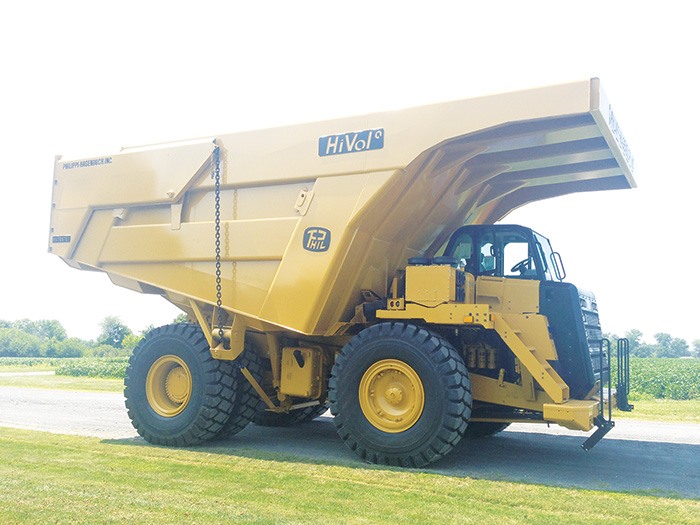
Spread Additional Opportunities
For haul trucks in landfills with additional challenges like high instability or low overhead clearances due to power lines or other obstacles, operations should consider a custom rear eject truck body. Like their counterparts, rear eject bodies are fully customized for the operation and designed to keep material in the truck and off the haul road. Rear ejects offer additional benefits for efficiency and operator safety. Rear eject bodies provide an ideal solution for constructing haul roads because they operate by pushing the material out the back of the truck body in a controlled fashion. This prevents the need to stop and raise the truck bed to dump material and allows for more even spread of the material along the haul road’s path. Additionally, rear ejects provide greater stability and the option to operate safely in low-clearance areas and on uneven surfaces common in landfills.
Once the initial phase of building the haul road is complete, operations can pair their rear eject with a material spreader attachment for finishing touches and ongoing maintenance. Material spreader attachments round out the haul road building process as they fine-tune and place any additional material needed for a smooth surface. Later, material spreaders fill in maintenance gaps—both literally and figuratively—to maintain a good base layer of material, effectively addressing the washboard effects and instability common on landfill haul roads. Rear ejects with material spreaders offer efficiency in other areas of the operation as well, such as applying daily cover. Some material spreaders handle aggregate material from very fine up to two inches with a spread width adjustable between approximately 5 feet to 60 feet or more (1.2 to 18.2 meters).
The spreader attachment also increases haul road maintenance efficiency when dealing with the effects of winter weather. When snow and ice lead to dangerous haul road conditions, the traditional action is to dedicate crews of up to four people to spend a whole day spreading sand for safety. This reallocation of labor and resources negatively affects the operation’s overall efficiency. With a rear eject body and material spreader, a single operator can effectively distribute sand, grit, or other crushed aggregate from the comfort of the vehicle’s cab, resulting in better workforce use and increased productivity for the waste operation.
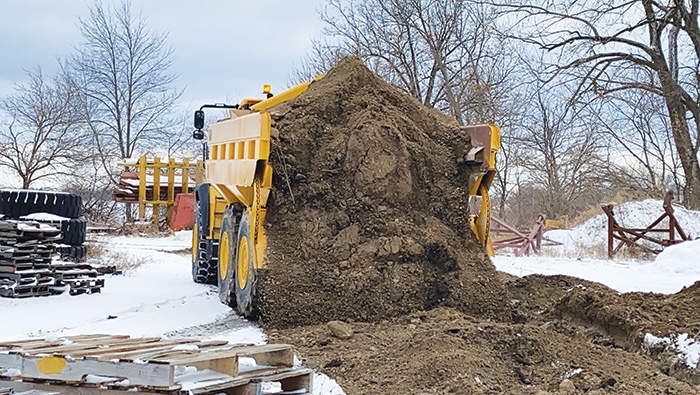
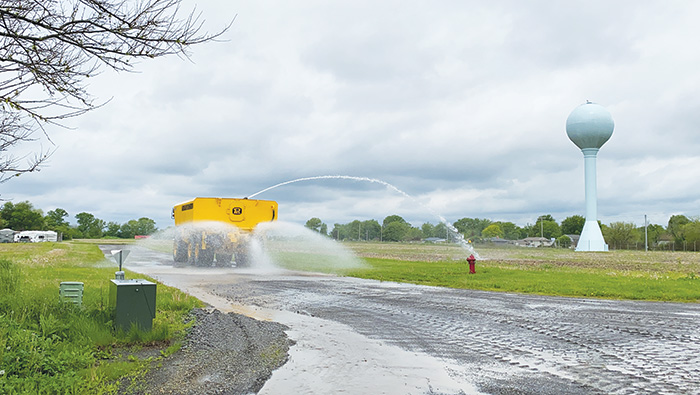
Water Tanks for the Win
Another integral product for haul road maintenance is a water tank. Often overlooked in importance, the water truck serves as an important tool for meeting EPA dust restrictions and extending the life of the haul road. However, to maximize safety and efficiency, a customized solution offers the best option. By incorporating a custom water tank design, waste operations can convert an older haul truck into a water truck, extending the life of the truck and maximizing their equipment investment. Properly spraying down haul roads prevents dust from migrating from the haul roads, thereby reducing the need to add more material as time goes on.
When looking for a water tank, do not overlook the shape of the tank. While it may seem insignificant, square tanks haul about 20 percent more water than round tanks with the same basic exterior dimensions. They also improve safety by creating a lower center of gravity. The tank’s baffling system should also be designed to prevent water from churning and surging to improve stability and overall safety.
Additionally, it is important to look for a water tank that provides drivers with precise control of the tank’s water output. Individually controlled spray heads make it easier for drivers to optimize water use while reducing the risk of oversaturating haul roads. With some systems, operators can turn on the individual spray heads and program a spraying interval. By boosting precision in water output, operations can increase safety and efficiency.
Change your Future Self Will Appreciate
When a waste operation sends a maintenance person or crew to clean and maintain a haul road, they give up the time that would otherwise be spent maintaining equipment. This impacts both productivity and the bottom line—10 hours of haul road maintenance could equate to $500 in labor expense—not to mention the additional expense in downtime and equipment use.
It is a simple fact that risks such as these are a part of business. However, just as an apple may help decrease the risks that lead to a doctor appointment, certain preventative maintenance practices in mines offer the potential to decrease the risk of future challenges. Haul road maintenance is one of those practices that offers operations a way to minimize future risks simply by planning ahead. | WA
Josh Swank is Vice President of Sales and Marketing for Philippi-Hagenbuch and oversees their global sales team. He has been with the company for more than 22 years. His previous roles within the company include global sales and marketing manager and project manager. Outside of Philippi-Hagenbuch, he participates in multiple industry and philanthropic organizations, including the National Mining Association Board of Governors, the National Stone Sand & Gravel Manufacturers & Services Executive Committee, and the NSSGA Young Leaders. He is a trustee of the JWAS Foundation, is the Chairman of the Peoria Riverfront Museum’s Collections Committee and active within the Peoria, IL, technology startup community. For more information, visit www.philsystems.com.
